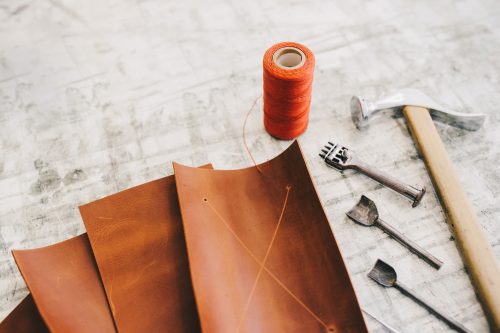Are you an artist interested in using resin as a new medium? It is a growing trend. The use of resin is rather simple. However, understanding which resin is best to use for molds and where to find products can be complicated when picking up a new hobby. We've done the work to inform you of the best resin to use.
You should consider the following questions when deciding on which resin to use:
- Is the resin clear and color-free?
- Is the resin for casting or coating?
- How long is the curing process?
The following 5 resins are excellent options for filling molds:
- Art 'N Glow Casting & Coating Resin
- Teexpert Epoxy Resin
- Castin' Craft Polyester Casting Resin
- Model-Pro Polyurethane Resin
- Let's Resin Silicone Resin
If you still have more questions, don't fret. In this guide, we'll go over each resin in more detail, ideas for DIY molds to create at home, and a list of items to purchase from Amazon. Continue reading to find out more!
![A person pouring white glitter resin into mold, What Is The Best Resin To Use For Molds? [5 Suggestions]](https://craftsbliss.com/wp-content/uploads/2020/10/What-Is-The-Best-Resin-To-Use-For-Molds.jpg)
The Three Things To Consider
Before you select your resin, you need to consider three things. Answering these questions helps determine which resin you should use.
Is The Resin Clear And Color-Free?
To determine if a resin is clear and color-free, look at the color of the resin itself. Clear resin is a transparent liquid that lacks any kind of coloring.
Is The Resin For Casting Or Coating?
Casting resin is clear and used to cast molds, figures, jewelry, etc. This is what the molds are filled with and then hardens during the curing process.
Coating resin is a protective outer layer used on top of a first application. This can make a project water resistant and glossy.
How Long Is The Curing Process?
The curing process varies on the type of resin used. Each kind of resin has a different curing process. Adding a heater or heating tool can also advance the time it takes to cure the resin. The curing process is also known as the drying process and can be anywhere between 30 minutes and a few days.
5 Excellent Resins To Use For Molds
In this section, we'll discuss each resin in more detail and provide you with excellent product examples.
Art 'N Glow Casting & Coating Resin
The Art 'N Glow casting and coating resin goes on super clearly and hardens well. The resin mixes easily with pigment powders.
The great thing about this casting resin is that it has great longevity. While there is little you can do about keeping a project from UV exposure, casting resin resists yellowing. Casting resin can also be used for coating and casting applications.
Casting resin is specifically a thin mixture. Due to this thin viscosity, the curing process is incredibly slow. The thinness of the casting resin could create more of a mess.
Click here to find this product on Amazon.
Teexpert Epoxy Resin
This product is a great resin to use because it is crystal clear. The order includes the epoxy resin and hardener to make the process easier. It also comes with 2 pairs of gloves, 2 graduated cups, and 4 stirring sticks.
Epoxy can easily be described as the best kind of resin to use for molds. This is because epoxy resin is well-known among the crafting community. It is highly accessible and often used for all purposes.
Most epoxy resins pour thick but unfortunately have a longer curing process. It is also important to remember that epoxies get more expensive the clearer the color.
Castin' Craft Polyester Casting Resin
This 128-ounce product is perfect for larger casts. It's crystal clear and durable. The downside of using this resin is that it is not protected against UV light. Therefore, the project will inevitably yellow over time.
Although this kind of resin is a type of casting resin, it has its own unique qualities. For instance, the polyester casting resin has a lower curing time than epoxy resin. The curing time can vary from minutes to hours, but always less than a day. The cures are a hard finish which can create more of a shine once finished.
Click here to find this product on Amazon.
Model-Pro Polyurethane Resin
This product, although dark in color, is great for making molds, models, figurines, and proof molds. This particular polyurethane hardens within 15 minutes and works best with silicone molds. The two-part product ensures durability and impact resistance.
Polyurethane resin is very similar to polyester in the sense that it has the same curing time. It can range from minutes to under an hour. However, the cost of the polyurethane resin is higher than polyester resin and can be in the same price range as epoxy. Polyurethanes also get more expensive the clearer or color-free it is.
Polyurethane has a low viscosity or thickness and is easy to mix. It is perfect for casting, not for coating.
Click here to find this product on Amazon.
Let's Resin Silicone Resin
The silicone resin is a great translucent mixture for mold making. It is easily cleaned up and a perfect start for beginners. There are no odors, toxins, or bubbles. Unfortunately, the finish can be rubbery compared to the other mixture finishes. If the stickiness stays, the curing time will need to be extended.
Silicone resin is a great material to use for making molds. The curing process is average and can take several hours. The price range is mid to upper and always more expensive for clear and color-free. It is great for casting and not intended for coating.
Click here to find this product on Amazon.
What Can You Use For A Resin Mold?
While you can certainly purchase pre-made resin molds, you can also use a handful of other items. There are items lying around the house that can be utilized for unique molds. Or, you can even create your own resin molds. We pulled together a few ideas for you to check out below:
Household Item Molds
Luckily for you, there are plenty of household items that can be turned into resin molds.
Cookie cutters make for excellent resin molds:
Cookie cutters are a great alternative for resin molds because they have simple shapes and designs. The cookie cutters can be placed on wax or parchment paper, similar to making cookies.
Ice tray molds can also be used for resin molds:
It is best to use silicone ice tray molds for an easier mold release. Ice tray mold designs are becoming more elaborate and great for handmade jewelry or keychains made with resin.
DIY Molds
There is an abundance of ideas for DIY molds! You can choose from silicone molds kits or create your very own designs.
EasyMold Silicone Putty is a great DIY mold project. The putty comes in two separate jars. To create the mold, you will have to mix the two together by pressing and rolling them into one combined putty. The mold forms quickly and must be pressed together within three minutes. After the components are mixed, you can place any desired shape into the material to create an impression.
The second DIY mold idea requires hot glue. The hot glue DIY mold works backward from the silicone putty mold. This means that the item designed for the impression will need to be placed on the surface first. Then the hot glue can be placed around the item chosen. The glue should create a cast over the item and dry to create a mold.
Can You Pour Resin Over Resin?
Resin can be applied over resin. This is considered a second coat if the first layer is dried and hardened. Second coats are used for fixing a mistake in the first layer or trying to make the surface thicker.
If you can, sand the first layer before pouring the second.
To repour a second layer of resin on top, repeat the steps used to create the first layer. For instance, measure out 1:1 mixture in mixing cups, stir, use a heating tool to remove air bubbles, and pour slowly. Then, wait for the designated time for the resin to cure. Repeat the process if the resin still looks sticky or bubbly.
What Can You Use To Color Resin?
To help a project really stand out, it is essential to add color. There are two forms of color to add to resin: liquid epoxy resin dye and powdered pigments.
The liquid resin dye is easy to use because little droplets are designed to come out of the bottle. A little dye can go a long way, especially when dying clear and color-free resin.
The powdered pigments are typically used in hand soap making, eyeshadow, and lipstick makeup kits. However, they are a great choice for adding to resin because they add vibrancy to any project.
Click here for powdered pigments on Amazon.
What Material Does Resin Not Stick To?
Resin can be very sticky and messy. Luckily, there are a few materials that do not stick to epoxy resin. For instance, vinyl, rubber, silicone, wax paper, and parchment paper are great for work surfaces. All of these materials allow the surface to be easily cleaned and pealed after completing a resin project.
In Closing
There you have it! There are several types of resin to use for molds and each can be used effectively depending on the project at hand. The most common is epoxy resin and it can be found at nearly every craft store both online and in-person. Remember to check out the DIY molds to create your very own original molds at home.










![Read more about the article Can You Sell Origami? [Here’s how to!]](https://craftsbliss.com/wp-content/uploads/2020/12/Cute-little-elementary-schoolgirl-doing-origami-fish-with-folded-color-paper-looking-video-on-laptop-Can-You-Sell-Origami-Heres-how-to-500x333.jpg)
